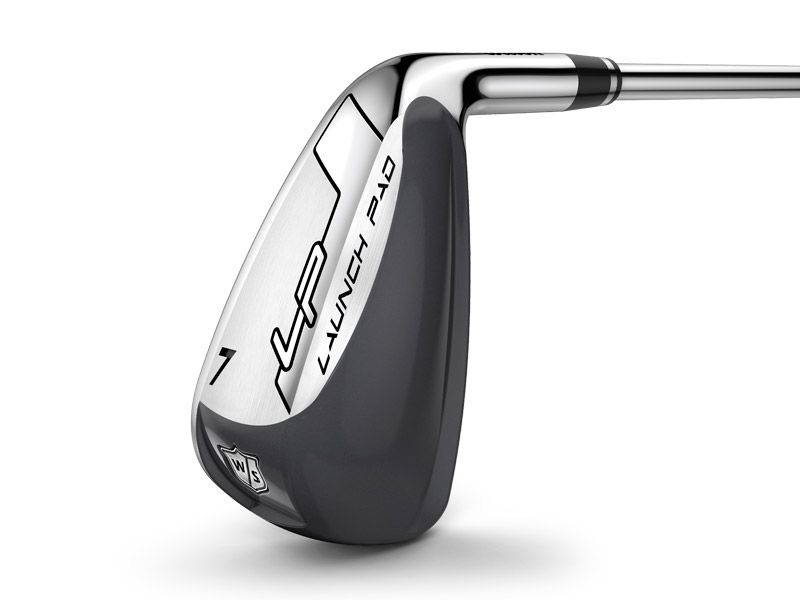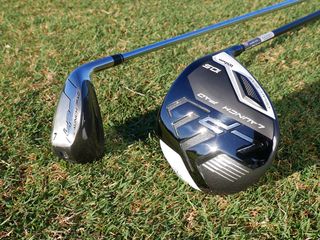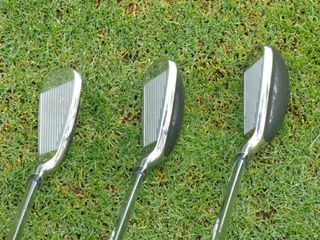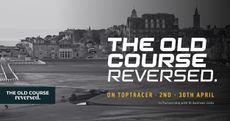Wilson Staff Launch Pad Iron
Joel Tadman tests the new Wilson Staff Launch Pad iron out on the course

I was very impressed with the Wilson Staff Launch Pad irons. They're not going to hit the ball for you and they're certainly not going to save a really poor swing, especially in wet conditions, but the margin for error on the strike is definitely larger on a club like this and if you’re a beginner or high handicapper it’s certainly an option worth trying. The price point of £549 for a set of seven clubs is very attractive too. Admittedly the looks will take some getting used to and they do feel quite firm and clicky but the Wilson Staff Launch Pad irons are definitely a contender for being the easiest irons to hit on the market in 2020.
-
+
The wide sole definitely provides extra assistance on ground-first contacts. Impressive accuracy and carry distance.
-
-
Unorthadox looks take some getting used to. Firm feel with quite a clicky sound.
Why you can trust Golf Monthly

In this Wilson Staff Launch Pad iron review article and video, Joel Tadman tests the theory of whether the effect of fat shots can be reduced
Wilson Staff Launch Pad Iron Review
The Wilson Staff Launch Pad iron claims to reduce fat shots by 73 per cent, but does it deliver on its promise? We took a 5, 7 and 9-iron to West Hill to find out.

Hybrid-iron sets are certainly making a comeback in 2020 and the reason the Launch Pad has the potential to be so easy to hit is because of its very wide sole with something Wilson is calling a late breaking bounce angle, said to keeps the leading edge up through the ground even if you catch the turf too early. The lightweight design also makes it easier for golfers to generate club speed with minimal effort.
Looks wise, these are very different and will take a fair amount of getting used, especially on the longer irons where you can see a lot of real estate behind the topline at address.

But it is a progressive set, so the soles become narrower as you work up to the pitching wedge. The wide sole makes me almost feel like I'm going to catch the shot heavy, which isn't ideal when standing over the ball.
So they’re easy to hit but do they go a long way? Well with the hybrid-like design you would think so and you’re certainly not losing as much on off-centre hits as you do with a conventional iron design but interestingly the lofts aren’t super strong on these. The 7-iron is 30° but the shaft length is 37.5 inches, so longer than most 7-irons on the market and the same length as a stock TaylorMade P760 6-iron.
Numbers wise from the Foresight Sports GCQuad using Titleist Pro V1x balls, the performance was solid if unspectacular. I got a club speed of 93.5mph translating into a ball speed of 126mph. The ball launched just under 18° with spin of 5400 rpm. Interestingly, the peak height of 36 yards is higher than average, but I have hit clubs higher than that – the Ping G710 iron had a peak height of 39 yards, for example.
That said, the Launch Pad 5-iron seemed to fly even higher than the 7-iron, which is something amateur golfers who struggle to flight their long irons will really appreciate.
All this created an average carry of 184 yards with the 7-iron. But the big thing to talk about is the dispersion. You get a lot of help on the strike from the sole but you also get a lot of help from the stability of the clubface to hit straight iron shots and that’s one thing I really noticed when hitting shots on the range.
Out on the course, I really wanted to put the claims about reducing the effect of fat shots to the test. So I set up a shot where I deliberately hit my current 8-iron fat and then did the same with the Wilson Staff Launch Pad 9-iron. The results blew me away.
With the wet conditions, the narrow sole on my current 8-iron dug down deep into the ground and the ball barely carried 60 yards. But with the Launch Pad, the divot was shallower and the clubhead slowed down much less - the ball must have carried over 100 yards. So clearly the wide sole is helping in reducing the effect of a heavy contact, although it is hard to put an exact figure on how much.
If you decide to buy one of these fantastic Wilson golf irons, first look at one of our Wilson promo codes.
Get the Golf Monthly Newsletter
Subscribe to the Golf Monthly newsletter to stay up to date with all the latest tour news, equipment news, reviews, head-to-heads and buyer’s guides from our team of experienced experts.

Joel has worked in the golf industry for over 15 years covering both instruction and more recently equipment. He now oversees all equipment and video content at Golf Monthly, managing a team of talented and passionate writers and presenters in delivering the most thorough and accurate reviews, buying advice, comparisons and deals to help the reader or viewer find exactly what they are looking for.
One of his career highlights came when covering the 2012 Masters he got to play the sacred Augusta National course on the Monday after the tournament concluded, shooting a respectable 86 with just one par and four birdies. To date, his best ever round of golf is a 5-under 67 back in 2011. He currently plays his golf at Burghley Park Golf Club in Stamford, Lincs, with a handicap index of 3.1.
Joel's current What's In The Bag?
Driver: Titleist GT3, 9°, Fujikura Ventus Black 6 S shaft.
Fairway wood: Titleist TSR3, 15°
Hybrid: Titleist TSi2, 18°
Irons: Titleist T150, 4-PW
Wedges: Titleist Vokey SM10, 50°, 54° and 58°
Putter: LAB Golf DF3
Ball: 2025 Titleist Pro V1x
-
 'I Think We All Hoped It Would Have Been A Little Further Long, And That's No Secret' - Brooks Koepka's Echoes Recent Tough Love Towards LIV Golf
'I Think We All Hoped It Would Have Been A Little Further Long, And That's No Secret' - Brooks Koepka's Echoes Recent Tough Love Towards LIV GolfThe five-time Major champion said progress is being made with the PIF-backed circuit after stating it was "quite far behind" its rivals on The Joe Pomp Show
By Jonny Leighfield Published
-
 How You Can Play St Andrews Old Course In Reverse
How You Can Play St Andrews Old Course In ReverseYou can win a tee time on the 'reversed' Old Course at St Andrews next year by shooting the lowest gross score over the virtual links this April
By Elliott Heath Published
-
 'He's Woefully Off His Game This Year' - Brandel Chamblee Labels Bryson DeChambeau 'Too Linear' To Enjoy Success At 'Abstract' Augusta National
'He's Woefully Off His Game This Year' - Brandel Chamblee Labels Bryson DeChambeau 'Too Linear' To Enjoy Success At 'Abstract' Augusta NationalQuizzed over the LIV golfer's prospects at The Masters in 2025 following a strong performance last term, Chamblee was not overly optimistic...
By Jonny Leighfield Published